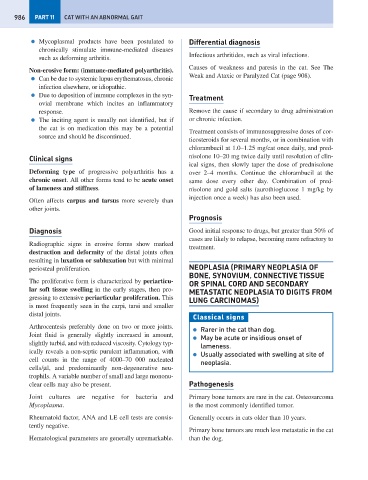Page 994 - Problem-Based Feline Medicine
P. 994
986 PART 11 CAT WITH AN ABNORMAL GAIT
● Mycoplasmal products have been postulated to Differential diagnosis
chronically stimulate immune-mediated diseases
Infectious arthritides, such as viral infections.
such as deforming arthritis.
Causes of weakness and paresis in the cat. See The
Non-erosive form: (immune-mediated polyarthritis).
Weak and Ataxic or Paralyzed Cat (page 908).
● Can be due to systemic lupus erythematosus, chronic
infection elsewhere, or idiopathic.
● Due to deposition of immune complexes in the syn-
Treatment
ovial membrane which incites an inflammatory
response. Remove the cause if secondary to drug administration
● The inciting agent is usually not identified, but if or chronic infection.
the cat is on medication this may be a potential
Treatment consists of immunosuppressive doses of cor-
source and should be discontinued.
ticosteroids for several months, or in combination with
chlorambucil at 1.0–1.25 mg/cat once daily, and pred-
Clinical signs nisolone 10–20 mg twice daily until resolution of clin-
ical signs, then slowly taper the dose of prednisolone
Deforming type of progressive polyarthritis has a over 2–4 months. Continue the chlorambucil at the
chronic onset. All other forms tend to be acute onset same dose every other day. Combination of pred-
of lameness and stiffness. nisolone and gold salts (aurothioglucose 1 mg/kg by
injection once a week) has also been used.
Often affects carpus and tarsus more severely than
other joints.
Prognosis
Diagnosis Good initial response to drugs, but greater than 50% of
cases are likely to relapse, becoming more refractory to
Radiographic signs in erosive forms show marked
treatment.
destruction and deformity of the distal joints often
resulting in luxation or subluxation but with minimal
periosteal proliferation. NEOPLASIA (PRIMARY NEOPLASIA OF
BONE, SYNOVIUM, CONNECTIVE TISSUE
The proliferative form is characterized by periarticu-
OR SPINAL CORD AND SECONDARY
lar soft tissue swelling in the early stages, then pro-
METASTATIC NEOPLASIA TO DIGITS FROM
gressing to extensive periarticular proliferation. This
LUNG CARCINOMAS)
is most frequently seen in the carpi, tarsi and smaller
distal joints.
Classical signs
Arthrocentesis preferably done on two or more joints.
● Rarer in the cat than dog.
Joint fluid is generally slightly increased in amount,
● May be acute or insidious onset of
slightly turbid, and with reduced viscosity. Cytology typ-
lameness.
ically reveals a non-septic purulent inflammation, with
● Usually associated with swelling at site of
cell counts in the range of 4000–70 000 nucleated
neoplasia.
cells/μl, and predominantly non-degenerative neu-
trophils. A variable number of small and large mononu-
clear cells may also be present. Pathogenesis
Joint cultures are negative for bacteria and Primary bone tumors are rare in the cat. Osteosarcoma
Mycoplasma. is the most commonly identified tumor.
Rheumatoid factor, ANA and LE cell tests are consis- Generally occurs in cats older than 10 years.
tently negative.
Primary bone tumors are much less metastatic in the cat
Hematological parameters are generally unremarkable. than the dog.

